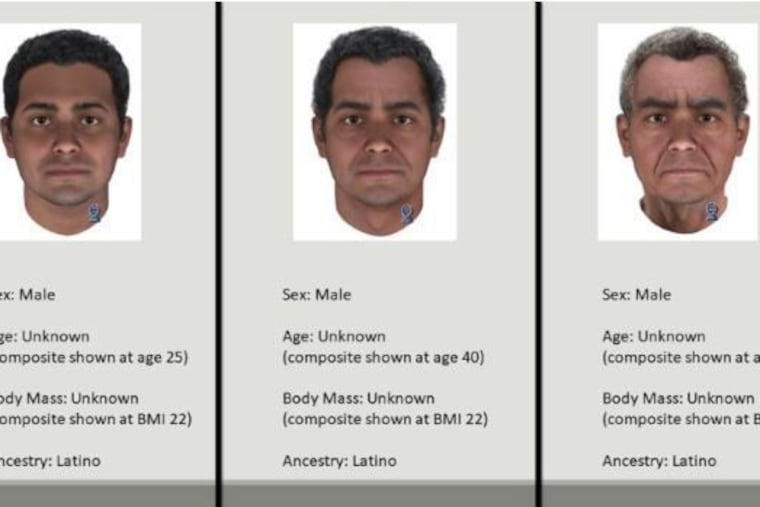Philly police release new sketches of the ‘Fairmount Park rapist,’ who is linked to four attacks, one murder
Nearly 20 years after he is alleged to have attacked the first of his 4 victims, the elusive "Fairmount Park Rapist" was back in the news Thursday when police announced developments in the open case.

Philadelphia police on Thursday released new composite sketches showing the man they believe to be the so-called Fairmount Park rapist, a never-identified suspect who has eluded capture for nearly two decades and whose DNA and other evidence linked him to sexual assaults of four women — one of whom he killed — between 2003 and 2007.
The new images were based on DNA phenotypic analysis, a process that allows forensic artists to predict someone’s physical characteristics and develop sketches of the person at various ages. It was the first time the department had used that technology, police said.
Although law enforcement officials have never been able to identify the assailant — and testing of DNA and genetic evidence has never provided a link to a suspect — investigators hope the sketches may help spur renewed interest in the cold case.
The images released Thursday show the assailant at ages 25, 40, and 60. And their publication marks the latest bid by police to seek tips in a case that has long left investigators baffled, and made women fearful of exercising alone in Fairmount Park, where three of the attacks occurred.
Police noted that the sketches cannot account for characteristics such as weight gain, changes to hairstyle or facial hair.
Police said the victims had previously described the assailant as a Hispanic man who spoke with an accent, 5-foot-8 with a muscular build, black hair, a thin mustache or jawline beard, and bushy eyebrows. Some victims said he had a widow’s peak hairline and wore an earring in his left ear, police said, and he was seen riding away from two scenes on a purple bicycle.
During the attacks, the suspect told his victims that he was lonely, that he came from a large family, and that he was from Puerto Rico, said Capt. Mark Burgmann, head of the Special Victims Unit.
”The MO’s always the same. He’d come up from behind, put them in a headlock. He’d produce that knife and he’d threaten them and drag them out of the area,” said Burgmann.
The assailant first struck on April 30, 2003, when police say he raped a 21-year-old woman at knifepoint at Kelly Drive and Fountain Green Road.
In the second attack, on July 13, 2003, at 3500 Conshohocken Ave., police say he raped and strangled Rebecca Park, 30, a fourth-year medical student at the Philadelphia College of Osteopathic Medicine.
» READ MORE: Woman recalls escape from Fairmount Park attacker: ‘I just felt his evil’ | 2004
She was last seen alive earlier that day and had told her boyfriend she was going for a jog. She usually ran on a trail through woods near her home on Lankenau Avenue in the River Park section of the city, The Inquirer reported at the time.
Four days after she disappeared, her battered body was found in a shallow grave covered with leaves about 30 feet from a trail near Conshohocken Avenue. Park was found clothed in only a sports bra and running shoes, police said.
On Oct. 25, 2003, the attacker attempted a sexual assault of a third woman at knifepoint on Martin Luther King Drive near Falls Bridge, but the 37-year-old jogger fought him off, suffering stab wounds to her neck, chest, and hand in the struggle, police said.
Nearly four years passed before he struck again, on Aug. 11, 2007, when police said he grabbed a 29-year-old woman from behind and dragged her into bushes, where he raped and robbed her at Frankford and Solly Avenues in Pennypack Park, about eight miles from the three earlier attacks.
» READ MORE: With DNA, police say the Fairmount Park rapist case is ‘solvable’ | 2004
All of the women were jogging or walking alone in secluded areas when they were attacked, police said.
Detective Ronald Kahlan said two of the victims were found and shown the sketches. “The two we talked to were happy to hear that we’re still working on the case,” he said.
Burgmann, of the Special Victims Unit, said two men whose DNA indicated that they are related to the suspect have been voluntarily tested, but neither test has led to a breakthrough.
The fact that there are no other matches for the suspect in existing DNA databases could be an indication that the assailant stopped committing crimes, moved away, or has died, he said.
Commissioner Danielle Outlaw urged anyone with information about a potential suspect to speak with law enforcement, saying in a statement: “Although these cases are decades old, the scars left behind from this offender’s actions still impact his victims and their families today.”